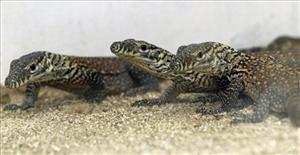Komodo Strory
Posted by Roni on 13th February, 2013
While juveniles are multi-hued (yellow, green, brown, gray), speckled, and banded with proportionally longer tails than adults, adult coloring varies depending on the island they are from. Body color of adult lizards from Flores is typically an earthen red with yellow heads whereas specimens from other islands range from slate gray to black.

Komodo dragons seem to be more advanced than other lizards with regards to their vision and sense of smell. Although they have poor vision in dim light, they can see objects as far as 985 feet away. Their forked tongues are like chemical analyzers, that recognize airborne molecules of prey items and determines which direction they come from. In fact, they are able to locate food from as far away as six miles if wind conditions are right. Though their hearing may not be as good as a human’s, their senses of smell and vision make them excellent predators.
As top line predators, Komodo dragons fill the same niche as other large carnivores such as big cats and wolves which are absent from the islands. Dragons feed on both live prey and decaying flesh, and are capable of killing deer, wild boar, and water buffalo, even though their diet consists mostly of Sunda deer. Much like big cats, Komodo dragons hunt larger prey by ambushing them and delivering a bite in a sudden aggressive move. They are capable of pursuit speeds of nearly 12 miles an hour in short bursts. If their prey is able to escape the immediate attack, the injured animal eventually succumbs to either blood loss or infection from the bite. The saliva of wild Komodo dragons contains more than 50 different strains of bacteria that rapidly lead to infection in their prey. A recent discovery of venom in the bites of these animals implies that venom may be used in subduing prey also, although specific research on
Komodo dragon venom action has not been completed.
Adults can eat up to 80 percent of their own body weight at a time and very quickly, too. Curved, serrated teeth and strong, sharp claws are used to reduce larger prey into ingestible pieces, although they are able to swallow large pieces of food by expanding their throats and flexible skulls. While large mammalian carnivores, such as lions, tend to leave 25 to 30 percent of their kill uncomsumed, these reptiles eat most of their prey, leaving very little to be wasted. Komodos eat much more efficiently, leaving only about 12 percent. They eat bones, hooves, hides and will also eat intestines, but only after swinging them vigorously to scatter their contents.
The mating season of Komodo dragons provides some interesting behaviors including ritual combat and wrestling to acquire the right to females. Females lay up to 30 soft, leathery eggs about a month after mating.
Female Komodo dragons dig a nest chamber in the ground for their eggs and cover it with earth and leaves. They then lie on the nest while the eggs are incubating, but there is no evidence of any parental care once the eggs hatch after about eight months. Hatchlings are about 14 inches long and have a high mortality rate, frequently falling prey to adult dragons and other species. As a result, hatchlings move to nearby trees once they are able to.

When they need to head to the ground, the young often roll in fecal material, thereby assuming a scent that the large dragons avoid. Hatchlings that live to adulthood usually have a lifespan of around 50 years but scientists are still studying this.
Komodo dragons are currently classified as endangered throughout their range. With only 4,000 to 5,000 remaining in the wild, the total land area occupied by Komodo dragons is less than 620 square miles, making it among the smallest ranges of any large predator anywhere in the world. The range of Komodo dragons, with the exception of the island of Flores, was declared
Komodo National Park in 1980. Indonesia accords this animal its highest level of protection and considers it a national treasure. The wild population of several thousand animals was projected to be relatively stable except on the island of Flores where they continue to face prey depletion and habitat destruction due to slash and burn farming, as well as the poaching of deer (one of the dragon’s staple foods).
Australian scientists have discovered that the world’s largest lizard packs a lethal venom in its bite, the Guardian reports. MRI scans of an ailing Komodo dragon revealed venom glands in the mouth that had never before been documented. The dragons’ poison sends victims into shock by triggering a sudden drop in blood pressure, and also prevents blood from clotting—causing the prey to bleed to death.
Last changed: 27th November, 2019 at 3:12 PM
Back to Overview


